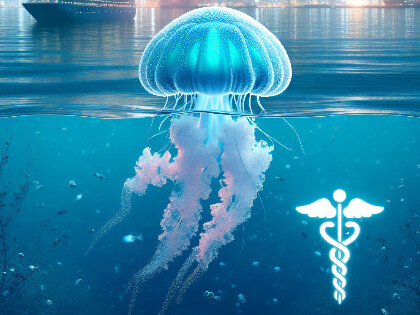
Jellyfish in Spain: What Tourists and Residents Need to Know

Spain is renowned for its picturesque beaches and crystal-clear waters, attracting millions of tourists every year. However, while swimming, you might encounter jellyfish. In this article, we will explore what you need to know about jellyfish in Spain, whether to fear them, and what to do if stung.
Jellyfish in Spain: General Information
Jellyfish are marine creatures that can be found in the coastal waters of Spain, especially during the warm summer months. The Mediterranean Sea, in particular, attracts various species of jellyfish, some of which can cause discomfort when they come into contact with human skin.
Main Types of Jellyfish in Spain:
- Pelagia noctiluca (Mauve Stinger) — the most common jellyfish, known for its glowing body and painful stings.
- Rhizostoma pulmo (Barrel Jellyfish) — a large jellyfish found in the Mediterranean Sea, with less painful stings.
- Aurelia aurita (Moon Jellyfish) — a harmless jellyfish often found in Spanish waters.
Should You Fear Jellyfish?
Jellyfish can cause discomfort and even pain upon contact with their tentacles, but there is no need to panic. Most jellyfish species found in Spanish waters do not pose a serious threat to human life and health. However, it is important to know how to avoid contact and what to do if stung.
How to Avoid Jellyfish Stings?
- Stay Informed — watch for information on the beaches. Warnings about jellyfish presence are often posted.
- Wear Protective Clothing — wetsuits and other protective gear can reduce the risk of stings.
- Be Vigilant — before entering the water, inspect it for jellyfish.
What to Do If Stung by a Jellyfish?
If you are stung by a jellyfish, follow these steps:
- Exit the Water — immediately leave the water to avoid further stings.
- Rinse the Wound — use seawater to rinse the sting site. Do not use fresh water as it can activate remaining nematocysts.
- Remove Tentacle Remnants — gently remove tentacles from the skin using tweezers or the edge of a credit card. Do not rub the wound with your hands.
- Apply Cold Compress — apply a cold pack to the sting site to reduce pain and swelling.
- Use Antihistamines — if you experience severe itching or swelling, antihistamines can help.
- Seek Medical Attention — if symptoms persist or worsen, seek medical attention immediately.
Jellyfish are a natural part of Spain's marine ecosystem. Knowing how to avoid stings and what to do if you come into contact with a jellyfish will help you enjoy your time on Spain’s beaches without unnecessary worries. Remember, most jellyfish stings can be successfully treated at home, but do not hesitate to seek medical help if necessary.
Stay safe and enjoy the beautiful beaches of Spain!


